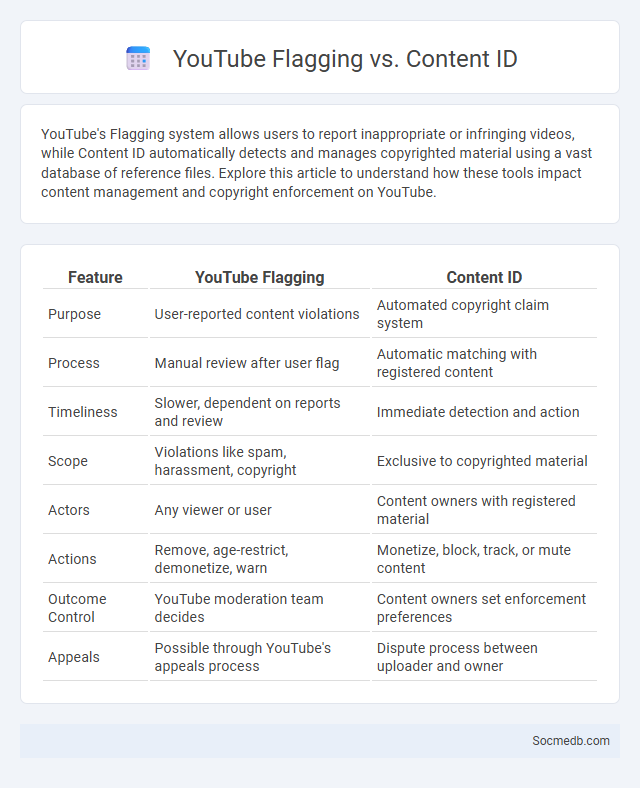
Photo illustration: YouTube Flagging vs Content ID
YouTube's Flagging system allows users to report inappropriate or infringing videos, while Content ID automatically detects and manages copyrighted material using a vast database of reference files. Explore this article to understand how these tools impact content management and copyright enforcement on YouTube.
Table of Comparison
| Feature | YouTube Flagging | Content ID |
|---|---|---|
| Purpose | User-reported content violations | Automated copyright claim system |
| Process | Manual review after user flag | Automatic matching with registered content |
| Timeliness | Slower, dependent on reports and review | Immediate detection and action |
| Scope | Violations like spam, harassment, copyright | Exclusive to copyrighted material |
| Actors | Any viewer or user | Content owners with registered material |
| Actions | Remove, age-restrict, demonetize, warn | Monetize, block, track, or mute content |
| Outcome Control | YouTube moderation team decides | Content owners set enforcement preferences |
| Appeals | Possible through YouTube's appeals process | Dispute process between uploader and owner |
Understanding YouTube’s Enforcement Mechanisms
YouTube enforces its community guidelines through a combination of automated systems and human reviewers to detect and remove content that violates its policies, such as hate speech, misinformation, and copyright infringement. The platform uses machine learning algorithms to scan videos and comments for potentially harmful material, enabling rapid identification and action. User reporting also plays a critical role, allowing the community to flag inappropriate content, which is then reviewed for possible removal or channel strikes.
What is YouTube Flagging?
YouTube Flagging is a user-driven process that identifies and reports content violating community guidelines, such as hate speech, misinformation, or copyright infringement. This system helps maintain platform integrity by enabling users to notify YouTube of inappropriate videos, which are then reviewed by content moderators. Effective flagging supports YouTube's efforts in content regulation and ensures a safer viewing environment for its over 2 billion logged-in monthly users.
Overview of YouTube Content ID
YouTube Content ID is a powerful digital rights management system that scans uploaded videos against a database of copyrighted material to identify matches. Rights holders can monetize, track, or block content automatically, protecting their intellectual property across the platform. Your use of Content ID ensures proper revenue sharing and legal compliance while maintaining the integrity of original works.
Manual Flagging vs Automated Detection
Manual flagging on social media relies on users reporting inappropriate content, enabling platforms to address violations based on human judgment but often resulting in slower response times. Automated detection employs artificial intelligence algorithms to identify harmful or violating content instantly, increasing efficiency but sometimes generating false positives or missing nuanced cases. Balancing manual flagging with advanced machine learning models enhances content moderation accuracy while maintaining user trust and platform safety.
How YouTube Flagging Works
YouTube flagging works by allowing users to report videos that violate community guidelines, such as inappropriate content, copyright infringement, or misinformation. Once a video is flagged, YouTube's automated systems and human reviewers assess the report to determine if the content should be removed or age-restricted. Understanding this process helps you maintain a safer and more reliable content environment on the platform.
How Content ID System Operates
The Content ID system scans videos uploaded to platforms like YouTube, matching audio and visual elements against a vast database of copyrighted material to identify potential infringements. When a match is found, the system automatically applies your preferred action, such as monetization, blocking, or tracking the content's performance. This automated process helps protect rights holders while allowing creators to manage the use of their content efficiently.
Key Differences: Flagging vs Content ID
Flagging allows users to report inappropriate or violating content manually, triggering review by platform moderators, while Content ID uses automated algorithms to detect copyrighted material and manage rights instantly. Your ability to flag targets specific issues or policy breaches, whereas Content ID primarily focuses on identifying and monetizing copyrighted content across social media platforms. Understanding these key differences helps protect your content and ensures compliance with platform rules.
Pros and Cons of YouTube Flagging
YouTube flagging empowers users to report inappropriate or harmful content, enhancing platform safety and community standards enforcement. However, the system can be exploited through false flagging, leading to content removal or demonetization without proper review, which impacts creators negatively. Balancing flagging efficiency with robust verification processes remains crucial for maintaining fair content moderation on YouTube.
Strengths and Limitations of Content ID
Content ID offers strong copyright protection by automatically identifying and managing copyrighted material across social media platforms, ensuring creators receive proper attribution and revenue from their content. Its high accuracy in matching audio and video reduces unauthorized use but may struggle with fair use cases or content filtering errors, leading to potential disputes. You must understand these strengths and limitations to effectively safeguard your content while navigating issues related to automated copyright enforcement.
Best Practices for Navigating YouTube’s Content Policies
Navigating YouTube's content policies requires a thorough understanding of community guidelines, copyright rules, and advertiser-friendly content standards to maintain channel integrity and avoid demonetization. You should consistently review YouTube's terms of service updates and utilize tools like Content ID to protect your original work while respecting others' intellectual property. Prioritizing clear, responsible communication and avoiding misleading or harmful content will help optimize your channel's reach and engagement.
 socmedb.com
socmedb.com